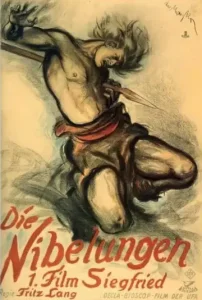Dragon's Roar, Hero's Fate: How Fritz Lang's 'Die Nibelungen: Siegfried' (1924) Forged Epic Cinema in the Fires of Myth!
In the golden age of Weimar Republic cinema, a visionary emerged whose monumental works would forever redefine the art of filmmaking: Fritz Lang. A master of German Expressionism and architectural grandeur, Lang was not merely a director; he was a cinematic architect, building vast, intricate worlds that explored the deepest recesses of the human psyche and the grand sweep of myth. Before his dystopian masterpiece Metropolis and his chilling crime thrillers, Lang undertook an endeavor of truly epic proportions: Die Nibelungen. This two-part silent saga, beginning with Siegfried (1924), wasn't just a film; it was a profound cinematic embodiment of Germany's most cherished national myth, the Nibelungenlied. It represents an early, groundbreaking fusion of mythological storytelling with unprecedented visual scale and meticulous production design, demonstrating cinema's power to translate ancient legends into a mesmerizing, grand spectacle that would inspire generations of epic filmmakers and establish Lang's reputation as a peerless creator of cinematic worlds.
Die Nibelungen: Siegfried plunges us into the legendary tale of the fearless hero Siegfried (Paul Richter), a prince renowned for his strength and courage. His journey is one woven from the threads of classic Germanic folklore: he slays a fearsome dragon (a truly magnificent, groundbreaking animatronic creature for its time), bathes in its blood to become invulnerable (save for a single spot), and acquires the coveted Nibelung treasure and the tarnkappe (cloak of invisibility). Driven by his desire for the beautiful Burgundian princess Kriemhild (Margarete Schön), he travels to the court of King Gunther (Theodor Loos). Here, a complex web of loyalty, deception, and fateful promises begins to ensnare Siegfried, as he uses his powers to help Gunther win the hand of the formidable Amazonian Queen Brunhild (Hanna Ralph), setting in motion a tragic chain of events dictated by pride and betrayal.
Fritz Lang's direction is nothing short of breathtaking, a masterclass in silent film spectacle and German Expressionist design. The film boasts colossal, architecturally inspired sets that evoke a mythic age, from the towering forests of the dragons' lair to the majestic halls of the Burgundian court. Lang's use of light and shadow, grand symmetrical compositions, and meticulously crafted special effects (most notably the terrifying dragon Fafnir and the mystical bird) creates an atmosphere that is both otherworldly and intensely dramatic. The acting, while often stylized as was common in the silent era, conveys the mythic archetypes with powerful physical presence. Every frame is a work of art, designed to immerse the viewer in a world of heroic grandeur and fated doom, proving that cinema could bring ancient myths to life with unparalleled visual poetry and scale.
Die Nibelungen: Siegfried was a massive commercial and critical success upon its release, lauded for its artistic ambition and technical achievements, and remains a foundational cult film for silent cinema enthusiasts and film historians alike. Its influence on later fantasy and epic films is undeniable. Fritz Lang directed this part, with the screenplay co-written by Thea von Harbou (Lang's wife and frequent collaborator). The "dragon" scene, featuring an elaborate mechanical beast, remains one of the most iconic and groundbreaking special effects of the silent era. The film's second part, Kriemhild's Revenge (1924), concludes the tragic saga. It stands as a monumental achievement, a timeless journey into myth and a testament to the boundless imagination of one of cinema's greatest architects.
Director: Fritz Lang.
Cast: Paul Richter as Siegfried, Margarete Schön as Kriemhild, Hanna Ralph as Brunhild, and Theodor Loos as King Gunther.
Special Info/Trivia: This is the first part of Fritz Lang's two-part Die Nibelungen saga, the second being Kriemhild's Revenge. The screenplay was co-written by Thea von Harbou. The dragon Fafnir was a large, hydraulically operated animatronic puppet, a groundbreaking special effect for its time. The film is a classic example of German Expressionist cinema and draws heavily from the ancient Germanic Nibelungenlied epic poem. It was a major commercial success and an influential work of cinematic spectacle.

